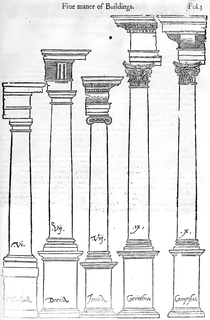
The Academy of Richmond County is a high school located in Augusta, Georgia, United States. Known previously as Richmond County Military Academy, it is commonly known as Richmond Academy or ARC.

The Augusta Canal is a historic canal located in Augusta, Georgia, United States. The canal is fed by the Savannah River and passes through three levels in suburban and urban Augusta before the water returns to the river at various locations. It was devised to harness the water power at the fall line of the Savannah River to drive mills, to provide transportation of goods, and to provide a municipal water supply. It is the only canal in the US in continuous use for its original purposes of providing power, transport, and municipal water.
Minard Lafever (1798–1854) was an American architect of churches and houses in the United States in the early nineteenth century.

The Owens–Thomas House & Slave Quarters is a historic home in Savannah, Georgia, that is operated as a historic house museum by Telfair Museums. It is located at 124 Abercorn Street, on the northeast corner of Oglethorpe Square. The Owens–Thomas House & Slave Quarters was designated a National Historic Landmark in 1976, as one of the nation's finest examples of English Regency architecture.
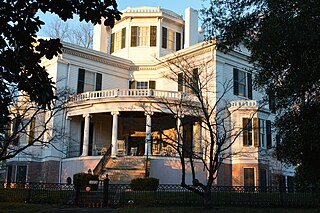
The Carmichael House, known also as Raines-Carmichael House, Raines-Miller-Carmichael House or Cadwalader Raines House, is a Greek Revival mansion at 1183 Georgia Avenue in Macon, Georgia, United States. Built in 1848, the house is a nationally significant example of Greek Revival architecture, built and designed by local master builder Elam Alexander. It was declared a National Historic Landmark in 1973.

The Octagon House, also known as May's Folly, is a historic octagon house at 527 1st Avenue in Columbus, Georgia. Built about 1830 and enlarged in 1863, it is claimed by the local historical society to be the nation's only known example of a double-octagon house. It was declared a National Historic Landmark in 1973.

The Stephen Vincent Benét House, commonly referred to as Benét House, is a historic house on the Summerville campus of Georgia Regents University in Augusta, Georgia. The house was built 1827–29 as the Commandant's House of the Augusta Arsenal, and is a much-altered example of Federal period architecture. The house was designated a National Historic Landmark in 1971 for its association with the Pulitzer Prize-winning writer Stephen Vincent Benét (1898–1943), who lived here in the 1910s. The house, which housed the official residence of the Augusta State University for a time, presently houses the Summerville campus's office of admissions.

College Hill, also known as George Walton House, Harper House, or Walton-Harper House, is a historic house at 2216 Wrightsboro Road in Augusta, Georgia. It was built in 1795, and was the home George Walton, a signer of the United States Declaration of Independence, from then until his death in 1804. It was declared a National Historic Landmark in 1971. It is a private residence, and is not open to the public.
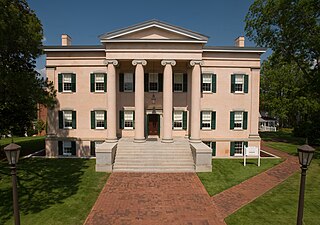
Georgia's Old Governor's Mansion is a historic house museum located on the campus of Georgia College & State University (GCSU) at 120 South Clarke Street in Milledgeville, Georgia. Built in 1839, it is one of the finest examples of Greek Revival architecture in the American South, and was designated a National Historic Landmark for its architecture in 1973. It served as Georgia's executive mansion from 1839- 1868, and has from 1889 been a university property, serving for a time as its official president's residence. It is an accredited museum of the American Alliance of Museums and in 2015 was named an affiliate of the Smithsonian Institution.

William Scarbrough House is a historic house at 41 Martin Luther King, Jr., Boulevard in Savannah, Georgia. Built in 1819, and subjected to a number later alterations, it is nationally significant as an early example of Greek Revival architecture, and is one of the few surviving American works of architect William Jay. The house was declared a National Historic Landmark in 1973. It is now home to the Ships of the Sea Maritime Museum, and it has largely been restored to an early 19th-century appearance.

Meadow Garden is a historic house museum at 1320 Independence Drive in Augusta, Georgia. It was a home of George Walton (1749–1804), one of Georgia's three signers of the U.S. Declaration of Independence, and later a governor of Georgia and a United States Senator. Meadow Garden was saved and established as a museum by the Daughters of the American Revolution in 1901. It was declared a National Historic Landmark in 1981.

Fountain Hall, formerly Fairchild Hall and Stone Hall, is a historic academic building on the grounds of Morris Brown College in Atlanta, Georgia. Built in 1882, it is the oldest surviving building originally associated with Atlanta University, one of the first historically black colleges and universities in the American South. It was declared a National Historic Landmark in 1974. It is now named after Bishop William A. Fountain.
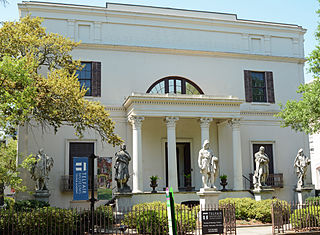
The Telfair Academy is a historic mansion at 121 Barnard Street in Savannah, Georgia. It was designed by William Jay and built in 1818, and is one of a small number of Jay's surviving works. It is one of three sites owned by Telfair Museums. Originally a family townhouse belonging to the Telfair family, it became a free art museum in 1886, and thus one of the first 10 art museums in America, and the oldest public art museum in the South. Its first director, elected in 1883, was artist Carl Ludwig Brandt, who spent winters in Savannah. It was declared a National Historic Landmark in 1976.

Augusta, Georgia was founded in 1736 as part of the British colony of Georgia, under the supervision of colony founder James Oglethorpe. It was the colony's second established town, after Savannah. Today, Augusta is the third-largest city in Georgia, and the largest city of the Central Savannah River Area.

Augusta Downtown Historic District is a historic district that encompasses most of Downtown Augusta, Georgia and its pre-Civil War area.

The Woodrow Wilson Boyhood Home is a historic house museum at 419 7th Street in Augusta, Georgia. Built in 1859, it was a childhood home of Woodrow Wilson (1856-1924), the 28th president of the United States and proponent of the League of Nations. The house is owned and operated by Historic Augusta, Inc., and was designated a National Historic Landmark on October 6, 2008.

St. Mary's Roman Catholic Church Complex is a historic multi-building church complex at 133 School Street in Waltham, Massachusetts. Established as a parish in 1835, it is the city's oldest Roman Catholic establishment. Its 1858 Romanesque Revival church and 1872 Second Empire rectory are particularly fine architectural examples of their styles. The complex was listed on the National Register of Historic Places in 1989.
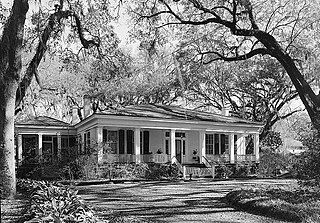
Georgia Cottage, also known as the Augusta Evans Wilson House, is a historic residence in Mobile, Alabama, United States. It was added to the National Register of Historic Places on September 14, 1972, based on its association with Augusta Jane Evans. She was one of the most popular American novelists of the nineteenth century and the first female author in the United States to earn over $100,000 for her work, but has been largely forgotten in recent times.

The Marsh-Warthen House in Lafayette, Georgia is a historic Greek Revival house that is listed on the National Register of Historic Places. It is open as a historic house museum and events venue, and is owned by the government of Walker County, Georgia.












